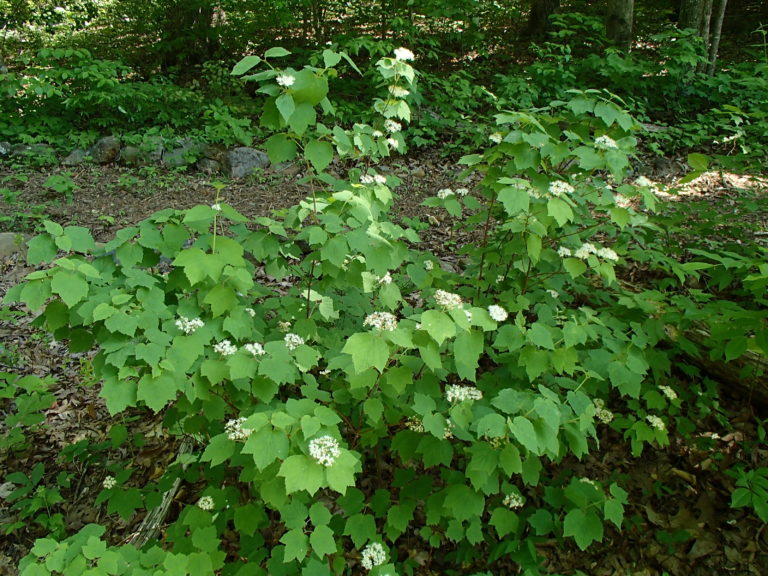Mapleleaf Viburnum is native to much of Eastern North America, inhabiting upland, dry woods. In NC, it is reported in mountain and piedmont counties only. It is a smaller member of the Viburnum genus, averaging only 4-6 feet tall. It suckers strongly, however, and forms colonies of sparsely branched shoots, and sited well (with space to spread) will reward the gardener with flowers in full, dry, woodland shade, very interesting foliage colors in fall and a large number of black berries for the birds. Mapleleaf Viburnum prefers dappled sunlight. It will adapt to fertile, loamy garden soil, but it owes its considerable success in natural areas to its ability to thrive in mesic to dry, shady conditions and a somewhat acidic soil that is rocky or sandy.
NURSERY HOURS
Wednesday: 10-4 Thursday: 10-6 Friday-Saturday: 10-4 Sunday: 12-4
Viburnum acerifolium

Key Info
Scientific Name: Viburnum acerifolium L.
Common Names: Maple-leaf Viburnum. Dockmackie
Family Names: Adoxaceae (Viburnum Family)
Plant Type: Tree / Shrub
Leaf Retention: Deciduous
Flower Color: White
Special Characteristics: Tolerates Black Walnut, Reported to be deer resistant., Attracts butterflies, Attracts birds, Tolerates shade
Additional Info
Habit: Strongly suckering to form multistemmed colony.
Height: 4' - 6'
Spread: 3' - 5'
Soil Conditions: Wet to dry, acid, rocky soils, sandy, sandy loam, medium loam, clay loam, clay.
Leaves: Opposite, "maple like" 2 - 5 inch leaves, 3-lobed, with toothed margins, medium green above and lighter and pubescent below; turn unusual shades of bright pinks and purples in fall.
Flowers (or reproductive structures: White, 1½ - 3 inch, flat-topped arrays (cymes) of fertile florets; individual florets are about ¼ inch across, with five small petals, that bloom in mid to late spring. Each flower gives way to a pea-sized fruit that ripens to bluish-black in late summer. The fruits may persist into winter.
Fruit: Clusters of red-turning-to-dark blue-black drupes about 1/3 inch long.
Natural Distribution: Mesic woods, bluffs, ravines, thickets.This is an understory plant in high quality wooded habitats where the shade is not too dense.
USDA Hardiness Zone: 4 to 8
USDA Wetland Indicator Status in NC: UPL
Pollination: Bees, butterflies, other insects
Wildlife Connections: The nectar and pollen of the flowers attract a range of bees and of flies, wasps, beetles, butterflies, and skippers. The caterpillars of several moths feed on the foliage. It is a larval host (and nectar source) for Spring Azure Butterfly. Viburnum berries are eaten by the Ruffed Grouse, Wild turkeys and many woodland songbirds including bluebirds, robins, and the northern flicker. To a lesser extent, these berries are also eaten by mice, chipmunks and various tree suirrels. White-tailed deer may browse on the twigs and leaves.(Illinoiswildflower.info)
Propagation: From cuttings and from seed.
